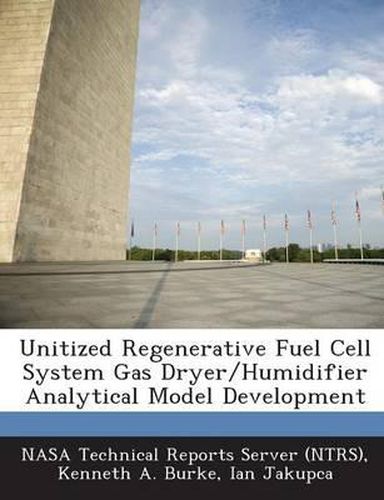Readings Newsletter
Become a Readings Member to make your shopping experience even easier.
Sign in or sign up for free!
You’re not far away from qualifying for FREE standard shipping within Australia
You’ve qualified for FREE standard shipping within Australia
The cart is loading…






A lightweight Unitized Regenerative Fuel Cell (URFC) Energy Storage System concept is being developed at the NASA Glenn Research Center (GRC). This Unitized Regenerative Fuel Cell System (URFCS) is unique in that it uses Regenerative Gas Dryers/Humidifiers (RGD/H) that are mounted on the surface of the gas storage tanks that act as the radiators for thermal control of the Unitized Regenerative Fuel Cell System (URFCS). As the gas storage tanks cool down during URFCS charging the RGD/H dry the hydrogen and oxygen gases produced by electrolysis. As the gas storage tanks heat up during URFCS discharging, the RGD/H humidify the hydrogen and oxygen gases used by the fuel cell. An analytical model was developed to simulate the URFCS RGD/H. The model is in the form of a Microsoft (registered trademark of Microsoft Corporation) Excel worksheet that allows the investigation of the RGD/H performance. Finite Element Analysis (FEA) modeling of the RGD/H and the gas storage tank wall was also done to analyze spatial temperature distribution within the RGD/H and the localized tank wall. Test results obtained from the testing of the RGD/H in a thermal vacuum environment were used to corroborate the analyses.
$9.00 standard shipping within Australia
FREE standard shipping within Australia for orders over $100.00
Express & International shipping calculated at checkout
A lightweight Unitized Regenerative Fuel Cell (URFC) Energy Storage System concept is being developed at the NASA Glenn Research Center (GRC). This Unitized Regenerative Fuel Cell System (URFCS) is unique in that it uses Regenerative Gas Dryers/Humidifiers (RGD/H) that are mounted on the surface of the gas storage tanks that act as the radiators for thermal control of the Unitized Regenerative Fuel Cell System (URFCS). As the gas storage tanks cool down during URFCS charging the RGD/H dry the hydrogen and oxygen gases produced by electrolysis. As the gas storage tanks heat up during URFCS discharging, the RGD/H humidify the hydrogen and oxygen gases used by the fuel cell. An analytical model was developed to simulate the URFCS RGD/H. The model is in the form of a Microsoft (registered trademark of Microsoft Corporation) Excel worksheet that allows the investigation of the RGD/H performance. Finite Element Analysis (FEA) modeling of the RGD/H and the gas storage tank wall was also done to analyze spatial temperature distribution within the RGD/H and the localized tank wall. Test results obtained from the testing of the RGD/H in a thermal vacuum environment were used to corroborate the analyses.